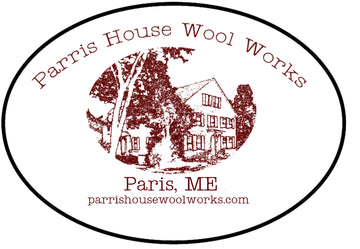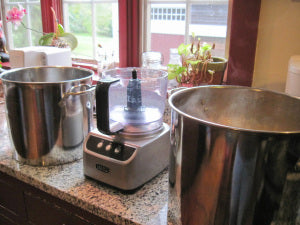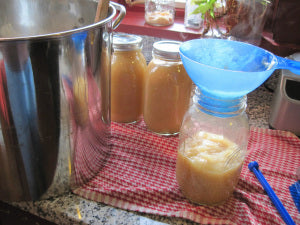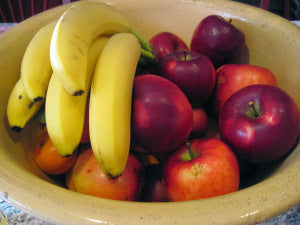Making Applesauce at The Parris House
Hi. It's Beth blogging today and it's fall in Paris, Maine! Here at The Parris House we have several apple trees which bear copious fruit every other year. It's an "on" year and so we are faced with apple overload. My husband picked about 24 pounds of apples from the trees last weekend, and of that, I cooked down about 18 pounds which yielded four quarts - one gallon! - of delicious applesauce. It's a super simple process which I will outline in this post.
So here are the apples. Those little itty bitty green things on top of the pile are pears from a positively ancient tree we also have in the yard, and which my husband subsequently made a pie with, but those don't figure in to our applesauce!
To give credit where it's due, the applesauce recipe comes from the Ball Blue Book Guide to Preserving. I have used this small but amazing book for making pickles, jams, and other preserved foods for several years now and every recipe has been bomb proof. It also explains the very important steps for a variety of preserving methods, and I have to say right up front: always follow the preserving directions for a recipe meticulously! Jen is a microbiologist and can attest to what happens if nasty critters (my very unscientific term - hey, I'm not the scientist...) get in to your food. So please, whenever you can or preserve, get a solid book like this one and follow the directions to a T.
I had to weigh the apples. The recipe said 2.5 to 3 pounds of apples per quart, although I don't think it quite worked out exactly that way. I got 4 and about 3/4 quarts (I didn't preserve the last 3/4 quart) out of about 18 pounds of apples.
Next it was time to peel and core the apples, much to the delight of...
our hens! Do you know what it looks like when you walk outside with a bowl full of fruit or veggie scraps here at The Parris House? It looks like this...
Those would be stampeding chickens. Too bad I wasn't taking video with sound.
While I was peeling, coring, and cutting up the apples, I ran the quart jars through the dishwasher. Even though I had done this, I also put them in to simmering water prior to filling them. Again...please follow the directions in your canning book precisely.
The apples went in to a large stock pot on the stove and cooked down in to a very soft state. Here is where you have some options. I chose not to add sugar or spices to my applesauce and leave it just 100% apples. I did this because I use applesauce for a variety of recipes and wanted it to be just apples to leave it versatile. Sugar or spices can be added upon opening if desired. Honestly, I like the pure taste of apples in my applesauce and choose to eat it just like this, but you can do as you desire. The Ball recipe book has the suggested amount of sugar if you'd like it sweetened.
Once cooked, it was time to puree the extremely hot - be careful! - apples in the food processor. You could also use an old fashioned crank food mill. I lined it up so that I could take the hot apples, put them through the processor, and in to a clean pot for a little further simmering.
Whirrrrrrrrrrrrrrrrrrrrr! Please don't mind the messiness on the handle and down the side. =/
At this point I was bringing water in my hot water boiler canner up to the boiling point. The pots behind my enamel canner hold the simmering empty jars and the lids and tools, all sterilized. Again...I know you're sick of hearing it...follow your canner's instructions.
Time to fill the jars using the sterilized equipment!
Once filled, I carefully lowered the jars in to the boiling water in the canner, and put the lid on. Putting the lid on helps insure that the water will remain at the boiling point. These jars are completely immersed with 1 to 2 inches of boiling water over the lids. This particularly recipe called for a 20 minute boiling/processing time. I'm sure processing time may vary according to your recipe and/or jar sizes.
While they were boiling I admired the eating apples we'd reserved out. Yum. Some of these went in to an apple cranberry crisp for our studio hookers a couple of days later.
OK! Once the processing time was up I super carefully, using my canning tongs, removed the jars from the boiling water bath and set them carefully on the counter. After a few minutes you'll hear the tell tale "PLINK!" of the jar seal lids popping down from the vacuum created as they cool. This must happen. If you have a jar that fails to do this, and therefore fails to properly seal, the contents must be either refrigerated and eaten in a reasonable amount of time, or you could try reprocessing that jar with a new seal lid. Again, follow your instructions! Do not touch or disturb your cooling jars for about 24 hours. Just let them rest before storing them in a nice, cool dry place.
As you can see, there are plenty of apples still on our trees. There are even a few on our ancient tree that probably remembers the 19th century Parris family, who now rest just beyond its branches.
I know this much. When it's time to peel another 18 pounds or so of apples, someone will be ready to take care of the scraps!
Thanks for reading and we'd love to hear about your fall preserving adventures too! Happy harvest and happy hooking! - Beth
- Parris House Wool Works



















Comments 0